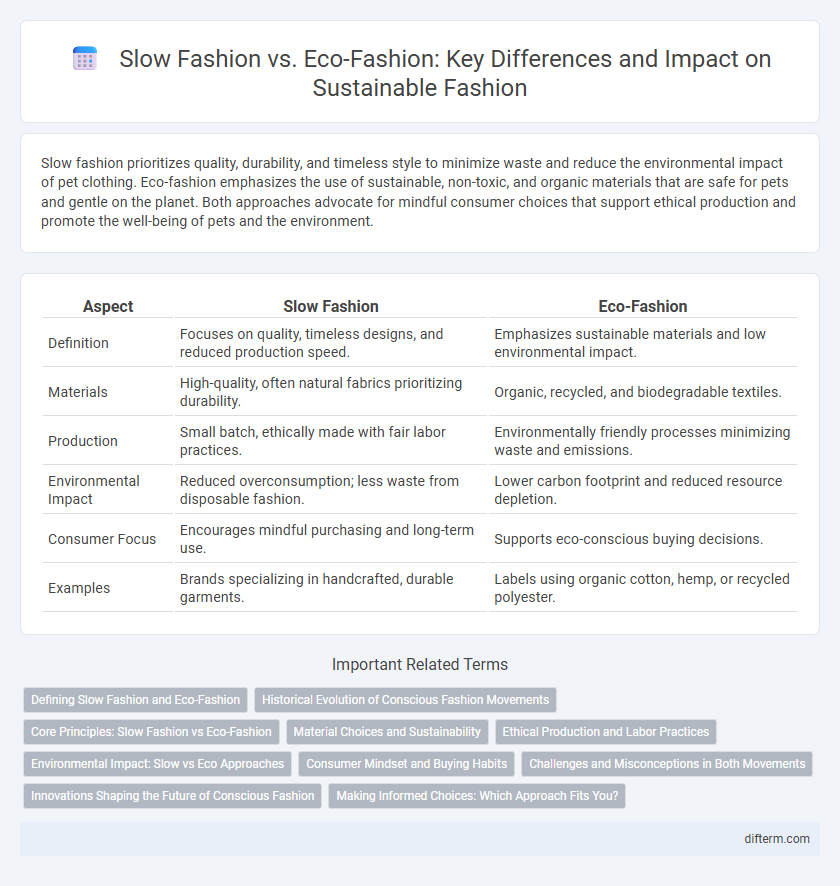Slow fashion prioritizes quality, durability, and timeless style to minimize waste and reduce the environmental impact of pet clothing. Eco-fashion emphasizes the use of sustainable, non-toxic, and organic materials that are safe for pets and gentle on the planet. Both approaches advocate for mindful consumer choices that support ethical production and promote the well-being of pets and the environment.
Table of Comparison
| Aspect | Slow Fashion | Eco-Fashion |
|---|---|---|
| Definition | Focuses on quality, timeless designs, and reduced production speed. | Emphasizes sustainable materials and low environmental impact. |
| Materials | High-quality, often natural fabrics prioritizing durability. | Organic, recycled, and biodegradable textiles. |
| Production | Small batch, ethically made with fair labor practices. | Environmentally friendly processes minimizing waste and emissions. |
| Environmental Impact | Reduced overconsumption; less waste from disposable fashion. | Lower carbon footprint and reduced resource depletion. |
| Consumer Focus | Encourages mindful purchasing and long-term use. | Supports eco-conscious buying decisions. |
| Examples | Brands specializing in handcrafted, durable garments. | Labels using organic cotton, hemp, or recycled polyester. |
Defining Slow Fashion and Eco-Fashion
Slow fashion emphasizes sustainable production with a focus on quality, timeless design, and ethical manufacturing practices to reduce waste and environmental impact. Eco-fashion centers on using environmentally friendly materials, such as organic cotton, recycled fibers, and non-toxic dyes, to minimize the ecological footprint of clothing. Both movements advocate for conscious consumerism but differ in scope: slow fashion prioritizes production pace and durability, while eco-fashion highlights the environmental aspects of textile sourcing and processing.
Historical Evolution of Conscious Fashion Movements
The historical evolution of conscious fashion movements traces back to the 1960s and 1970s when environmental and social awareness began influencing consumer behavior, marking the origins of slow fashion focused on durability and ethical production. Eco-fashion emerged in the 1990s as a subset emphasizing sustainable materials, reduced waste, and lower carbon footprints, aligning with global climate initiatives. Both movements have expanded significantly in the 21st century, driven by increasing transparency, technological advancements in sustainable textiles, and heightened consumer demand for responsible fashion choices.
Core Principles: Slow Fashion vs Eco-Fashion
Slow fashion emphasizes quality craftsmanship, timeless design, and reducing consumption to extend garment lifespan, while eco-fashion prioritizes sustainable materials, minimizing environmental impact, and ethical production practices. Both movements advocate for transparency and social responsibility but differ in their primary focus: slow fashion targets consumer behavior and durability, eco-fashion centers on ecological footprint and resource efficiency. Embracing slow fashion reduces waste through mindful purchasing, whereas eco-fashion drives innovation in sustainable textiles and renewable resources.
Material Choices and Sustainability
Slow fashion prioritizes high-quality, durable materials such as organic cotton, linen, and recycled fibers, which extend garment lifespan and reduce waste. Eco-fashion emphasizes sustainable sourcing, including biodegradable fabrics, low-impact dyes, and regenerative agricultural practices that minimize environmental footprints. Both approaches advocate for circularity and responsible consumption to combat the fast fashion industry's ecological harm.
Ethical Production and Labor Practices
Slow fashion prioritizes ethical production and labor practices by emphasizing fair wages, safe working conditions, and transparent supply chains, contrasting with fast fashion's exploitative labor models. Eco-fashion integrates these ethical standards with environmental sustainability, ensuring materials and processes reduce ecological impact while supporting workers' rights. Both movements advocate for responsible consumption, but eco-fashion places stronger emphasis on reducing the carbon footprint and chemical use alongside labor ethics.
Environmental Impact: Slow vs Eco Approaches
Slow fashion emphasizes producing durable, timeless clothing through ethical labor practices, significantly reducing waste and overproduction's environmental footprint. Eco-fashion prioritizes sustainable materials like organic cotton, hemp, and recycled fabrics, minimizing resource depletion and chemical pollution. Both approaches aim to lower the environmental impact but differ in focus: slow fashion targets consumption patterns, while eco-fashion centers on material sourcing and production processes.
Consumer Mindset and Buying Habits
Consumers embracing slow fashion prioritize quality, durability, and timeless style, leading to more thoughtful purchases and reduced wardrobe turnover. Eco-fashion buyers focus on sustainability, seeking garments made from organic or recycled materials and supporting brands with transparent ethical practices. Both mindsets promote conscious consumption, shifting away from fast fashion's disposable culture toward investments in long-lasting, environmentally responsible clothing.
Challenges and Misconceptions in Both Movements
Slow fashion faces challenges in scaling sustainable production while maintaining quality, often misunderstood as merely being about longer-lasting clothes rather than systemic change. Eco-fashion encounters misconceptions that all sustainable fabrics are expensive or less durable, creating barriers for widespread adoption. Both movements struggle with consumer education and balancing environmental impact with accessibility and style.
Innovations Shaping the Future of Conscious Fashion
Innovations in slow fashion integrate sustainable materials such as organic cotton and recycled fibers, reducing environmental impact while promoting quality craftsmanship. Eco-fashion harnesses advanced technologies like biodegradable dyes and 3D knitting to minimize waste and energy consumption in production. These innovations collectively drive the future of conscious fashion by aligning ecological responsibility with consumer demand for transparency and durability.
Making Informed Choices: Which Approach Fits You?
Slow fashion emphasizes quality, timeless designs, and ethical production, prioritizing durability and reduced waste over trends. Eco-fashion centers on sustainability through environmentally friendly materials and processes, minimizing carbon footprints and resource consumption. Understanding your values and lifestyle helps determine whether slow fashion's longevity or eco-fashion's green innovations align best with your wardrobe goals.
slow fashion vs eco-fashion Infographic

 difterm.com
difterm.com